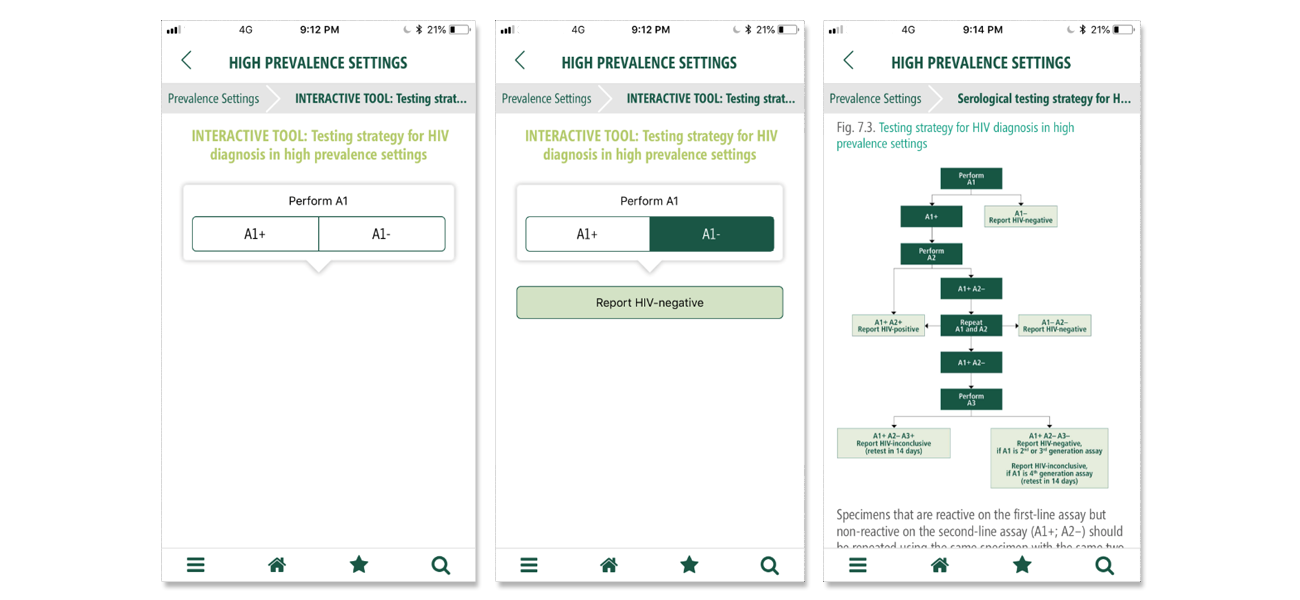November 2018 – The first WHO guidelines app, “WHO HTS Info”, from the Department of HIV, was launched at the International AIDS Conference in Amsterdam in July 2018.
This app provides easy, on-the-go access to current HIV testing services (HTS) guidelines and information on your smartphone or tablet, whether you are online or offline. This story summarizes how the app was developed and highlights its key features and plans.
Why create an app?
WHO conducted pre- and post-test guidelines development surveys for the 2015 “Consolidated guidelines on HTS” and the 2016 supplement “Guidelines on HIV self-testing and partner notification”.
The surveys found users wanted the guidelines to be more accessible, especially when they were performing field duties. They also wanted all of WHO’s HTS guidelines and recommendations to be available in one place in a user-friendly format. A mobile phone app was identified as one solution.
Users thought having the guidelines in an app would allow them to:
- refer to the guidelines when in the field, even when no internet connection is available
- cease carrying printed copies of the guidelines in the field
- always have access to the latest version and newest updates
- switch translations easily.
In response, the Department of HIV decided to develop an app to bring together WHO’s existing HTS guidance and recommendations in a single and convenient platform.
How was the app developed?
To gain an understanding of user preferences regarding content, design, features and resources for the app, WHO embarked on a consultative process.
WHO conducted more than 20 semi-structured interviews with key stakeholders, including WHO staff, ministries of health, funding agencies, and technical and implementing partners representing WHO regions in Europe, Africa and Asia.
An electronic survey, which received 483 responses, was also conducted over 3 weeks. Respondents included people from ministries of health, national reference laboratories, the private sector, and implementers from all WHO regions. Throughout this process, WHO identified core features that would best serve the requirements of most app users.
WHO undertook several steps to develop the app, before launching it at the International AIDS Conference in Amsterdam in July 2018. During the conference, several app demonstrations were held at the WHO booth in the Global Village. The app kiosk attracted several delegates who were interested in trying the app.
Since its release in July 2018, the WHO HTS Info app has been downloaded by 449 unique devices – resulting in 2 700 sessions.
Most users and sessions have come from Asia, Europe and Africa, with fewer users from Oceania, the Eastern Mediterranean and the Americas. By country, most sessions were from India, the Netherlands, the United Kingdom of Great Britain and Northern Ireland, Switzerland, Zambia, the United States of America, Nigeria, the Philippines, Uganda, and South Africa. Other countries that have used the app include: Algeria, Argentina, Australia, Botswana, Cambodia, Cameroon, Canada, Congo, Croatia, the Democratic Republic of the Congo, Denmark, Egypt, Ethiopia, Fiji, France, Germany, Greece, Guatemala, Iceland, Jordan, Kazakhstan, Kenya, Kuwait, Lebanon, Lesotho, Libya, Lithuania, Malawi, Malaysia, Pakistan, Qatar, Rwanda, Saudi Arabia, Senegal, Spain, Thailand, Tunisia, Ukraine, the United Republic of Tanzania, Viet Nam and Zimbabwe.
Who is the app for?
The app was designed for everyone who uses the WHO guidelines, but particularly those directly involved in planning and delivering HTS, including:
- ministries of health
- providers and field staff
- implementing partners
- donors and funding agencies
- community groups and civil society
- academics and researchers
- WHO staff across the different regions and countries.
What are the key features?

The app is designed so that users experience the familiar format and text layout, with additional features. Some of the key features include:
- Offline use and automatic updates: use the app even if there is no internet connection. The app content updates automatically when connected to the Internet.
- Content: full text of both WHO 2015 and 2016 guidelines available through the app. The app also provides links to related WHO guidelines and useful resources.
- Recommendations: view all WHO HTS recommendations in one place. Browse WHO recommendations by population, testing strategy or service delivery approach.
- Interactive testing strategies: explore WHO’s recommended HIV testing strategies for high- and low-prevalence contexts in an interactive format.
- Search: find the WHO recommendations and guidelines you need.
- Favourites: save the content you use most often for easy access.
- Share: like and share WHO recommendations and content via email or social media.
- Browse: read WHO guidance and other resources related to your area of interest.
Due to the success of the WHO HTS Info app, the Department of HIV will continue to disseminate future HTS guidelines through the app. New languages and data features will be added later this year.
